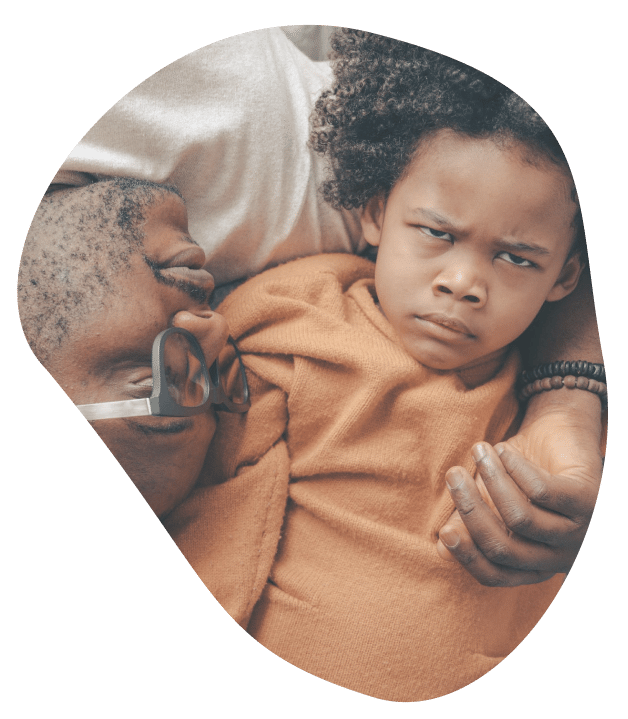Understanding and Overcoming
Enmeshment in Families
Have you ever felt like you and your family members were maybe a little too close for comfort?
Maybe you have difficulty separating your own thoughts and feelings from those of your parents or siblings. Or perhaps you feel smothered by their constant need for connection and attention. If so, you may be experiencing enmeshment in your family dynamic.
Family enmeshment involves a lack of emotional boundaries between family members, where individual identities blur. It can occur in any relationship, but is most common in parent-child and romantic relationships.
While the adverse effect of enmeshment can be significant, knowing that you can break free from it can be reassuring.
To answer all of your questions about enmeshment in families, this article will cover:
- What parental enmeshment is, and how it links with attachment theory
- The characteristics of an enmeshed mother-child relationship
- An explanation of the enmeshed father-child relationship
- How to break free from family enmeshment
Parental Enmeshment and Attachment Theory
Enmeshment is a term used to describe an overly close and intertwined relationship. It could be between family members or in a romantic relationship. However, in family enmeshment, boundaries between family members blur, with individuals sharing similar thoughts, feelings, and behaviors.
Enmeshment can occur in any family system, and it’s often driven by a desire to maintain close relationships or protect family members from harm. However, enmeshment can negatively affect the mental and emotional well-being of family members, especially children.
Do you know your attachment style?
Take our attachment quiz and find out now – fast, easy, free.
Effects of Enmeshment on
Family Members
While being close to family members can be comforting, enmeshment is distinctly different. For children, enmeshment can lead to a lack of autonomy and independence. Enmeshed children may feel like they can’t make decisions on their own without their parent’s approval.
Furthermore, children experiencing enmeshment may feel guilty or ashamed if they don’t comply with their family’s wishes. They may also struggle to develop their own identity, as their sense of self ties in so closely with their family’s identity.
Enmeshed parents may struggle to let go of their children. They may also:
- Make decisions for them, often leading to feelings of anger, resentment, and guilt in the child in the long run.
- Feel responsible for their children’s actions and emotions, causing burnout and emotional exhaustion.
- See their relationships outside the family unit deteriorate as a consequence of continually focusing on their children.
Overall, evidence suggests that family enmeshment leads to overall increased family stress and less relationship satisfaction.


How Enmeshment Relates to Attachment Theory
Attachment theory is a psychological framework that focuses on how people form bonds, particularly during childhood. According to attachment theory, early attachment bonds play a critical role in shaping a person’s sense of self-worth, security, and ability to form healthy relationships in later life.
Evidence suggests that anxious attachment is associated with enmeshment. Children from enmeshed families are more likely to have an anxious attachment style. Furthermore, maternal attachment anxiety may increase enmeshment, which can cause a cycle of anxious attachment in their children.
On the other hand, maternal avoidant attachment often triggers avoidant attachment in their children. Parents with an avoidant attachment style typically sit on the opposite end of the spectrum of family closeness to anxiously attached parents. In extreme circumstances, these parents may display emotional disengagement toward their children.
It’s important to note that attachment theory isn’t the only factor affecting enmeshment. Many components may influence the extent to which a family is enmeshed. For example, family dynamics can be passed trans-generationally. Enmeshment is likely to occur if the mother, father, OR grandmother experienced enmeshment in their own families.
Enmeshment in the Mother
Enmeshment mothers typically become so overly involved in their child’s life that it hinders the child’s independence. Various factors can trigger enmeshment in mothers, including:
- The want to be their child’s “best friend”
- Losing a child
- A series of difficult events (such as illness, social difficulties in their own childhood, or trauma).
These events can result in “helicopter parenting” (also known as “overparenting”). Helicopter parenting occurs when a parent pays intense attention to their child and fiercely protects them. While protectiveness and attention are good parenting behaviors, extreme levels can stifle a child’s development. However, it’s important to note that enmeshment mothers may not realize that they’re overly involved in their childrens lives.
Mother-Son Enmeshment
Mother-son enmeshment occurs when the relationship crosses the line from healthy boundaries into unhealthy closeness. According to mother-son enmeshment psychology, the son learns from an early age that being independent is not “OK,” which influences their thoughts and behaviors.
Mother-son enmeshment is typically more common when the mother shows narcissistic tendencies, referred to as narcissistic mother-son enmeshment.
The signs of mother-son enmeshment are:
- Lack of personal boundaries
- Overly dependent relationship
- Inappropriate closeness (such as having overly intimate conversations about their lives)
- Difficulty separating
- Emotional manipulation (from the mother)
- Feelings of obligation toward the mother (from the son)
The following mother-son enmeshment checklist can help you determine whether this is something you’re experiencing:
Mother-Son Enmeshment Checklist
- Do I have my own personal space, or do I have to share every aspect of my life with my mom?
- Do I feel reliant on my mom for emotional support and to help with decision-making?
- Does my mom use emotional manipulation or guilt-tripping behaviors?
- Is my mom over-involved in my life?
- Do I feel responsible for my mom’s emotional well-being?


Mother-Daughter Enmeshment
Mother-daughter enmeshment occurs when the roles between mother and daughter become blurred. This enmeshment results in the daughter having less autonomy and independence. Narcissistic tendencies in the mother can exacerbate enmeshment, leading to a dynamic of narcissistic mother-daughter enmeshment.
Signs of mother-daughter enmeshment may include:
- The mother having an unhealthy amount of control over her daughter’s life
- The mother being overly involved in her daughter’s life
- Mother and daughter feeling emotionally fused or dependent on one another
- The daughter caring for and feeling responsible for her mother’s emotional needs
- The daughter experiencing fear of intimacy in romantic relationships
- A struggle on behalf of the daughter for understanding who she is
The following mother-daughter enmeshment checklist can help you determine whether this is something you’re experiencing:
Mother-Daughter Enmeshment Checklist
- Is my mother is overly involved in my life?
- Are boundaries difficult to establish with my mom?
- Do I feel guilty asserting my own needs and wants?
- Do I ask myself, “what would mum think?” when making decisions?
- Feeling responsible for my mum’s emotional needs is common for me?
- Do I have difficulties setting boundaries in relationships?
- Do I know myself, including my interests and values?
Enmeshment Father
The enmeshment father has similar behaviors to the enmeshment mother, whereby they try to control their child’s emotions, thoughts, and behaviors. It’s important to note that an enmeshed parent may not realize they’re asserting control over their children – this may originate in their childhood experiences.
Father-Daughter Enmeshment
Enmeshment in the father-daughter relationship occurs when a father is overly involved in his daughter’s life. This over-involvement makes the relationship emotionally unhealthy and potentially damaging.
The father-daughter enmeshment signs are the same as the mother-daughter enmeshment signs, involving a lack of boundaries, control, emotional manipulation, and difficulty separating.
However, father-daughter enmeshment may become particularly heightened when the daughter begins to date. At this stage, a father may show fierce over-protectiveness, disapproval, and emotional manipulation, potentially trying to micromanage her decisions and dictate who she can and cannot date.
The following father-daughter enmeshment checklist can help you determine whether this is something you’re experiencing:
Father-Daughter Enmeshment Checklist
- Do you feel like you don’t have your own interests or activities and spend most of your time with your dad?
- Does your dad try to control your decisions and not allow you to take risks?
- Does your father have difficulty accepting that you’re growing up and becoming independent?
- Is jealously or anger something your father exhibits when you prioritize your own needs over his?
- Do you feel responsible for your dad’s emotional well-being or feel it’s your job to fix his problems?
- Are guilt or anxiety common for you when you feel you can’t meet your dad’s expectations?
- Do you have difficulty establishing healthy boundaries in relationships?


Father-Son Enmeshment
Enmeshment fathers try to control or become too involved in their sons’ lives in a way that prevents them from developing an individual identity.
Common signs of father-son enmeshment include:
- Emotional dependence: The father depends on his son for emotional support and validation.
- Difficulty with authority: The son may have trouble respecting authority figures other than his father.
- Emotional manipulation: The father uses emotional manipulation tactics (like guilt-tripping) to control his son’s actions and decisions.
- Guilt and obligation: The son may feel guilty or obligated to choose their father’s needs over theirs.
- Lack of autonomy: The son may struggle to establish his own sense of identity and independence, as his thoughts and feelings are entangled with his father’s.
The following father-son enmeshment checklist can help you determine whether this is something you’re experiencing:
Father-Son Enmeshment Checklist
- Does your dad use you as a confidante, sharing his adult issues with you?
- Is your dad overprotective of you?
- Are you a source of emotional support for your dad?
- Do you get the sense that your dad doesn’t want you far away from him?
- Does it feel like your dad asks for inappropriate information about your life?
- Do you feel like your dad is deeply involved in your life?
- Is guilt something you experience when you want to spend time with other people rather than your dad?
- Is your dad overly reliant on you?
- Do you feel responsible for your dad’s happiness?
- Do you struggle to know what you want to do, what activities you like, and your values?
Breaking Free From Family Enmeshment
Breaking free from family enmeshment can be challenging, but it is possible. And it has benefits. Understanding and addressing family enmeshment can help you build healthy relationships with friends, family, and romantic partners. What’s more, breaking free from enmeshment can also make you feel more confident in yourself and your identity.
The following steps may help you when breaking free from family enmeshment:
#1 Recognize the Problem
The first step to overcoming family enmeshment is acknowledging that enmeshment is a problem within your family. While this stage may sound simple, it can be tough as families often view enmeshment as “normal.” This circumstance is especially true in families where enmeshment is trans-generational.
Recognizing that family enmeshment isn’t the “norm” of a healthy relationship can help you start to address the problem.

#2 Set Clear Boundaries
Setting clear boundaries with family members is important, as enmeshment often pushes past personal limits. This stage involves identifying behaviors you consider acceptable or not from your family members. Moreover, setting clear boundaries also involves choosing to no longer allow family members to make decisions on your behalf.
Setting clear boundaries promotes healthy relationships and better adaptation to the various expectations of you and your responsibilities within your family and outside of this unit.
#3 Develop a Sense of Individual Identity
One of the most vital steps in breaking free from family enmeshment is carving out your own identity. When families become enmeshed, family members (particularly children) tend to lose a sense of their identity – their interests, values, and goals.
Developing your identity can help you recognize what’s important to you, including what you wish to pursue in life.
You can develop your own identity by:
- Pursuing your interests
- Taking time to reflect on your values and beliefs
- Trying new things
- Connecting with others who share similar interests
- Practicing self-reflection

#4 Try Family Therapy
Family therapy is an excellent way to heal family enmeshment trauma and carve out your individual identity. What’s more, family therapy allows all family members to come together to discuss enmeshment issues.
Together, you can gain a new perspective on family dynamics and identify unhealthy patterns. Through therapy, you can also build healthy boundaries and address underlying issues, including attachment difficulties.

The Bottom Line on Family Enmeshment
Enmeshment in families can be detrimental to the mental and emotional well-being of everyone involved, particularly children. Enmeshed children may struggle to make their own mark in the world and carve their own paths.
Family enmeshment is associated with anxious attachment, with maternal anxiety exacerbating enmeshment. However, mothers and fathers can both exhibit enmeshment behaviors, and enmeshment can be passed down trans-generationally.
If you have identified patterns of enmeshment in your family, know that breaking free is possible. It takes time and effort, but can lead to greater independence, autonomy, and healthy relationships.
Even if you’ve experienced enmeshment from a very young age, it’s important to remember that it’s never too late to start living your life on your own terms.
Barber, B. K., & Buehler, C. (1996). Family cohesion and enmeshment: Different constructs, different effects. Journal of Marriage and the Family, 58(2), 433–441.
Bögels, S. M., & Brechman-Toussaint, M. L. (2006). Family issues in child anxiety: attachment, family functioning, parental rearing and beliefs. Clinical psychology review, 26(7), 834–856.
Bradshaw, J. (1989). Our families, ourselves: The consequences of
codependency. Lear’s, 2(1), 95-98.
Hann-Morrison, D. (2012). Maternal Enmeshment. SAGE Open, 2(4).
Schiffrin, H. H., Liss, M., Miles-McLean, H., Geary, K. A., Erchull, M. J., & Tashner, T. (2014). Helping or Hovering? The Effects of Helicopter Parenting on College Students’ Well-Being. Journal of Child and Family Studies, 23(3), 548–557.
Vitulić, H. S., Gosar, D., & Prosen, S. (2022b). Attachment and family functioning across three generations. Family Process.








 Get mental health tips straight to your inbox
Get mental health tips straight to your inbox